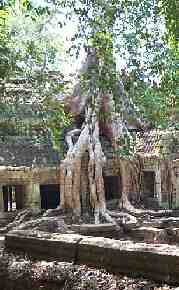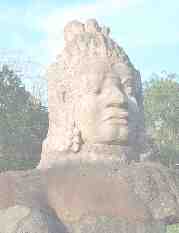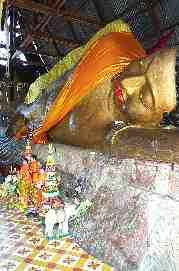
Siem Reap and the Temples
Monday / 13 March 2000 |
- We started off the day at the Bayon temple, one of the largest and most magnificent. It has 54 huge stone towers, each with 4 ten-foot stone faces facing north, south, east, and west. Most impressive to me, though, were the different levels of temple. Visitors can go down inside tunnels and chambers below ground and also explore other chambers two levels above ground.
- We visited several other temples nearby, lesser known wats in varying stages of ruin. It is interesting to see the jungle reclaiming the ancient stone ruins with huge trees completely surmounting the massive stone walls.
- We then drove to the gates of Angkor Wat which was to be our final stop and ate lunch at a French restaurant. Numerous children tried--and succeeded!--to sell us various souvenir-type articles, mainly the kramara (the cotton scarves/towels/sarongs that the Khmers wear and use for everything), flutes, bamboo toys, and T-shirts. It is hard to acknowledge that this is the only life those kids know. They cannot go to school and don't have much of a future.
- After lunch we crossed the road to Angkor Wat and started exploring the massive ruins, the largest in the whole area. We didn't allow nearly enough time for this part of our expedition. There are three levels of temple to explore, surrounded by and complemented by huge courtyards and "tanks" or large cisterns which were probably more decorative than functional.
- After too short a time at Angkor Wat, we headed back along the dusty roads to the hotel where we had fifteen minutes to wipe off the dust before we headed to the airport. Siem Reap airport was jammed with people. Now that the government has allowed international flights directly to Siem Reap, the city has taken on a positive new prominence and tourism is strong. It is a beautiful city to begin with, and with all the ancient ruins surrounding it, it is a magnet for tourists.
- The rest of the group flew back to Phnom Penh and I waited another hour and took a flight to Bangkok where I stayed about 36 hours. I searched for a computer printer and a clock radio, but didn't buy anything, and then updated my home page from the Maryknoll center house there in Bangkok. Then I caught an early morning flight back to Phnom Penh where I was successful this time in getting my Official Category NGO visa which was denied on my earlier entry. All was not smooth sailing, however. It seemed the officials had never seen an "attestation letter" required by the new rules and so no one wanted to make a decision about it. It was almost comical as 16 different immigration people, looked at it, held it up to the light, felt the embossed stamp, and then passed it on to someone else.
|


